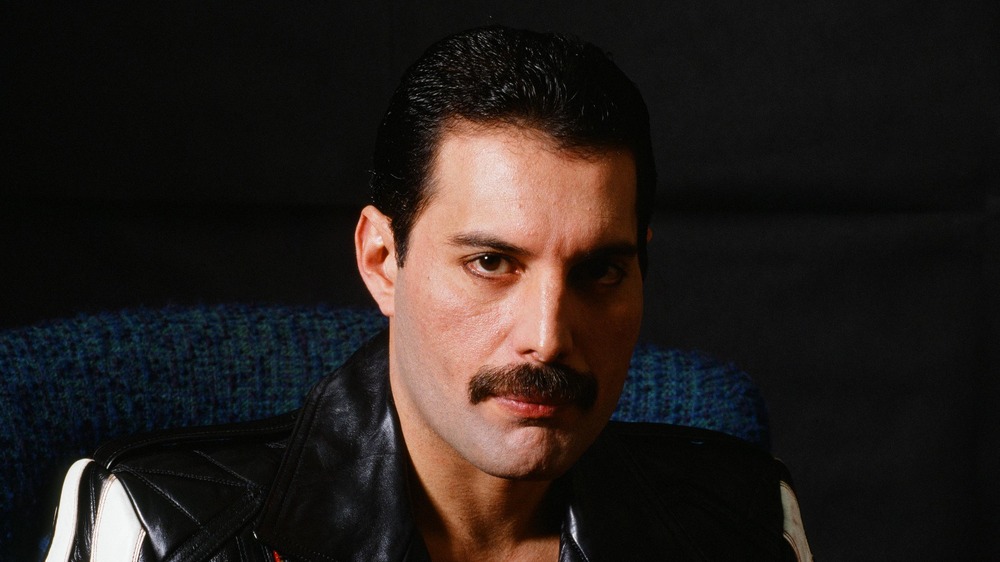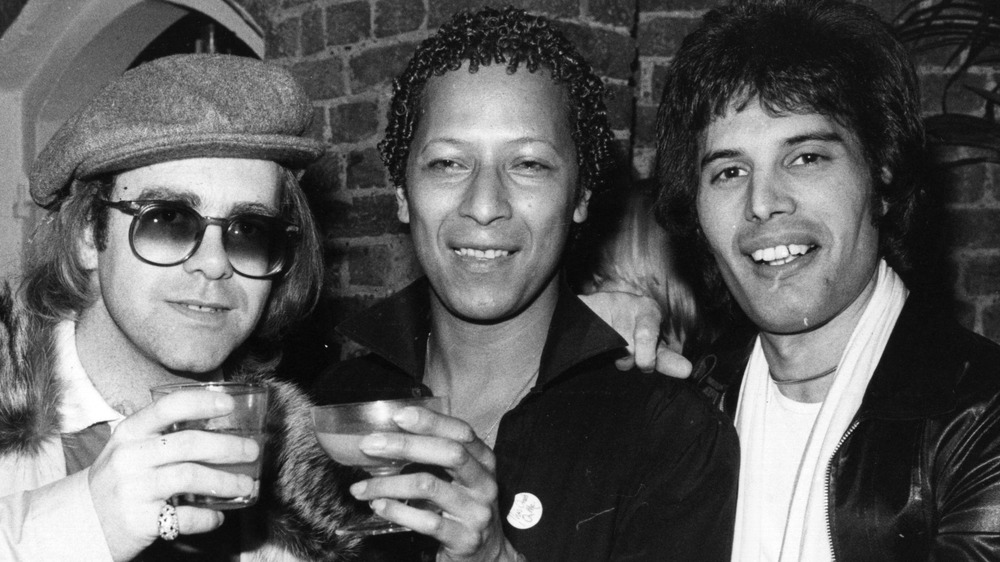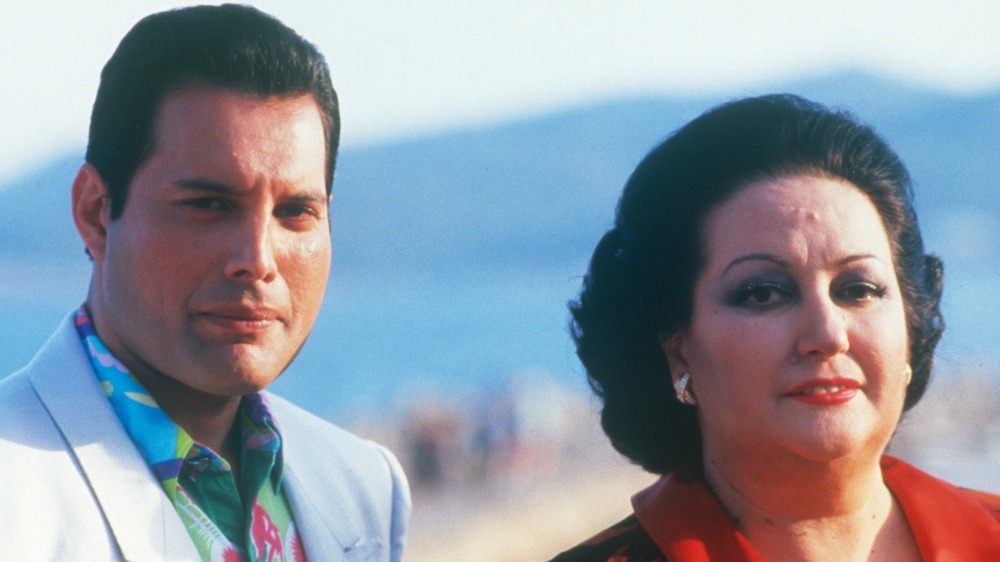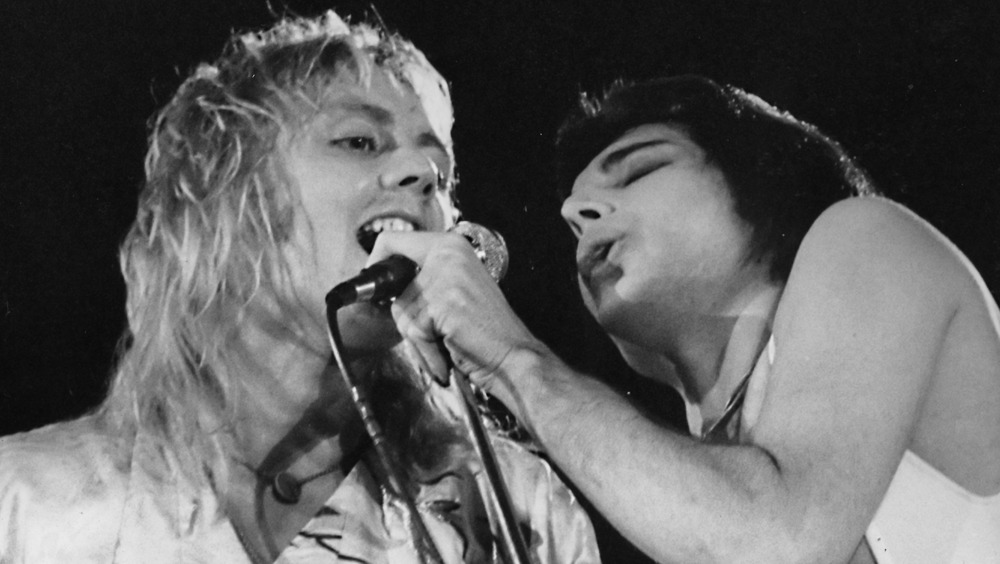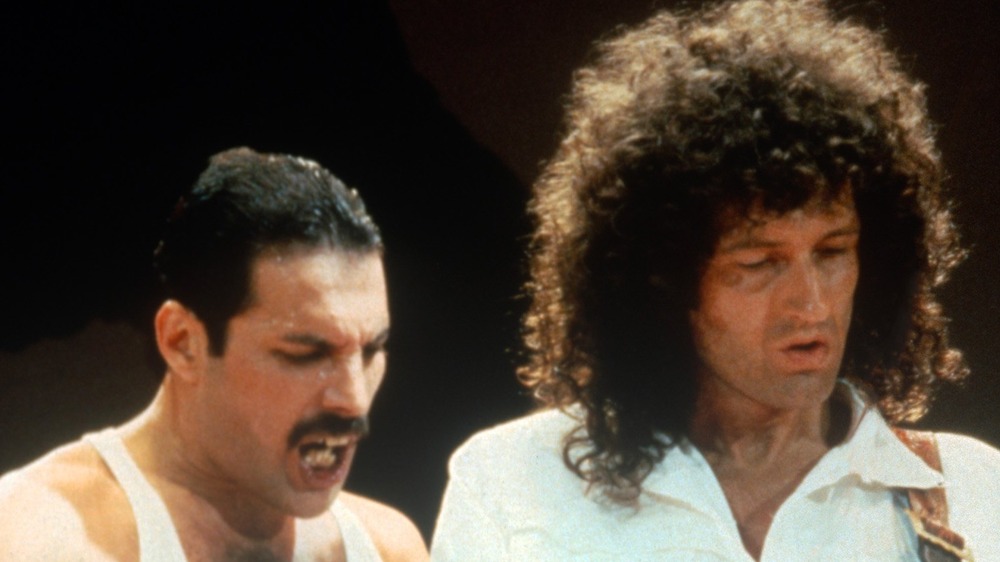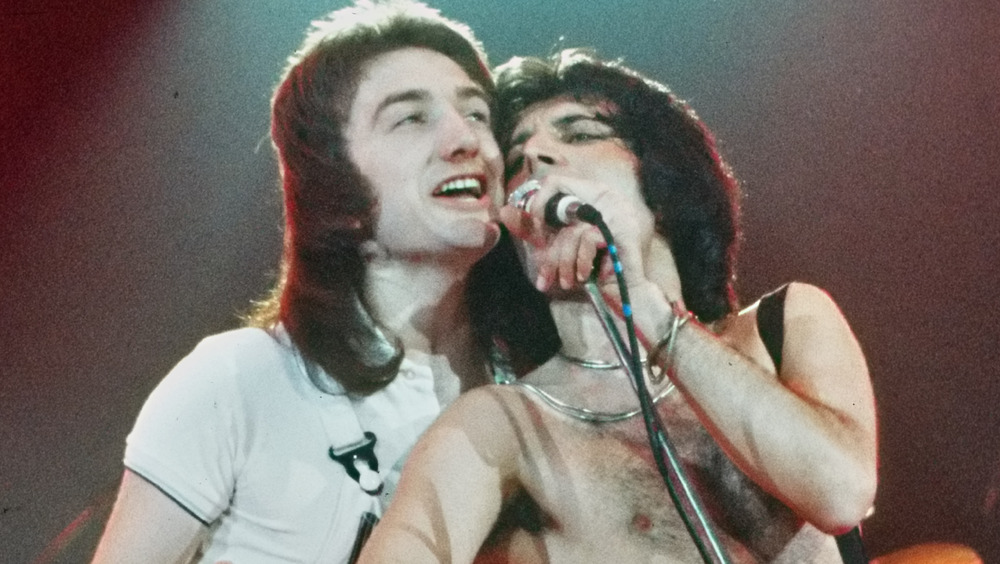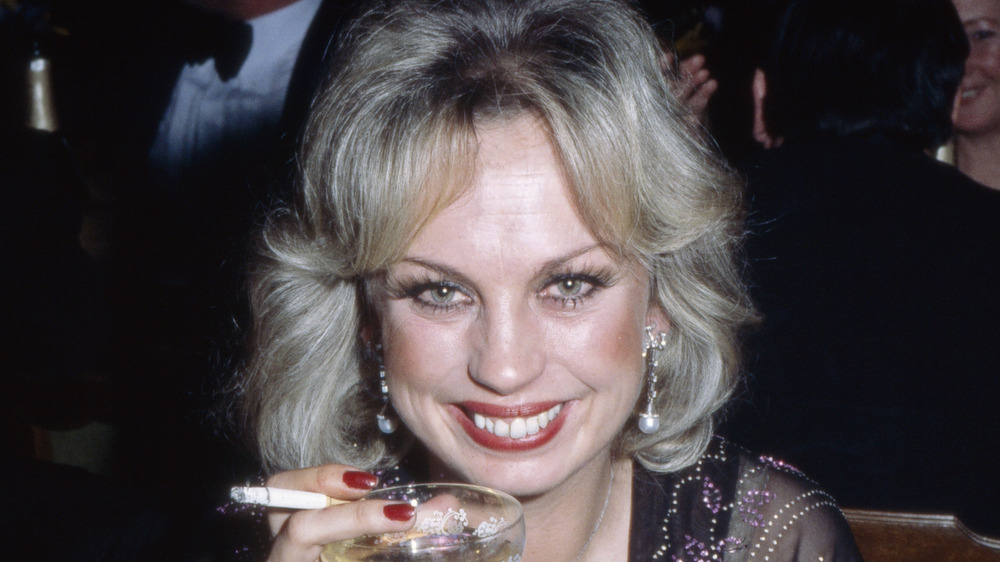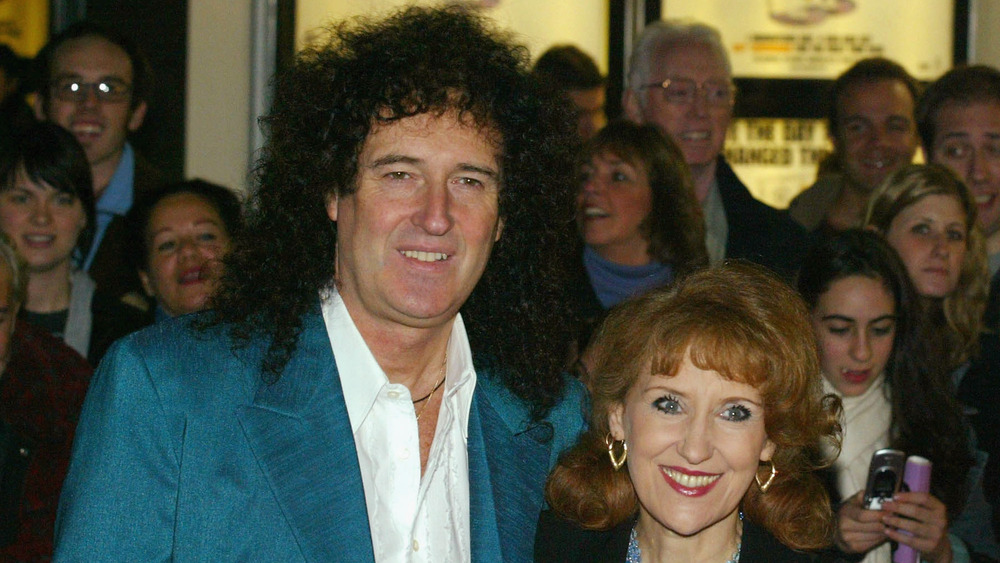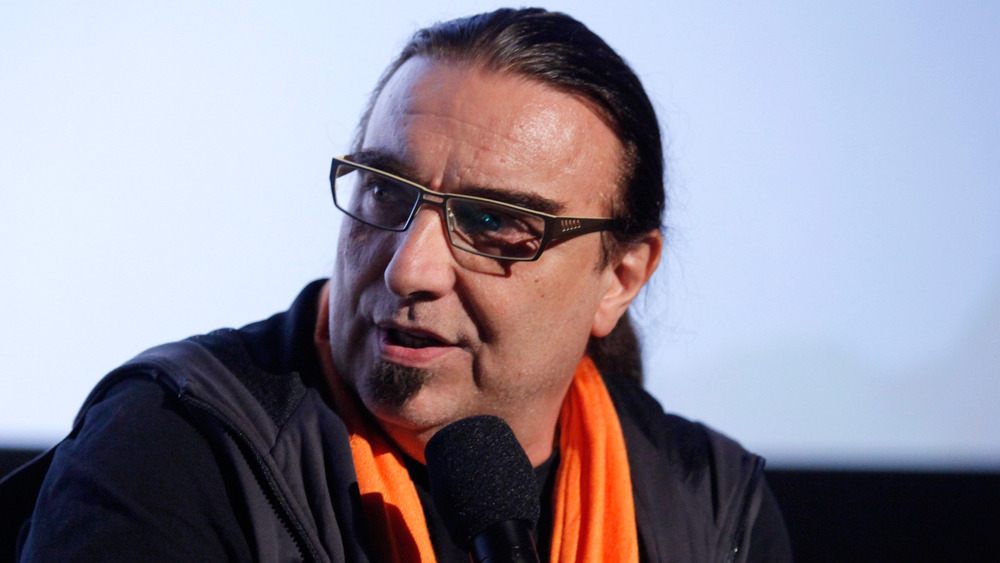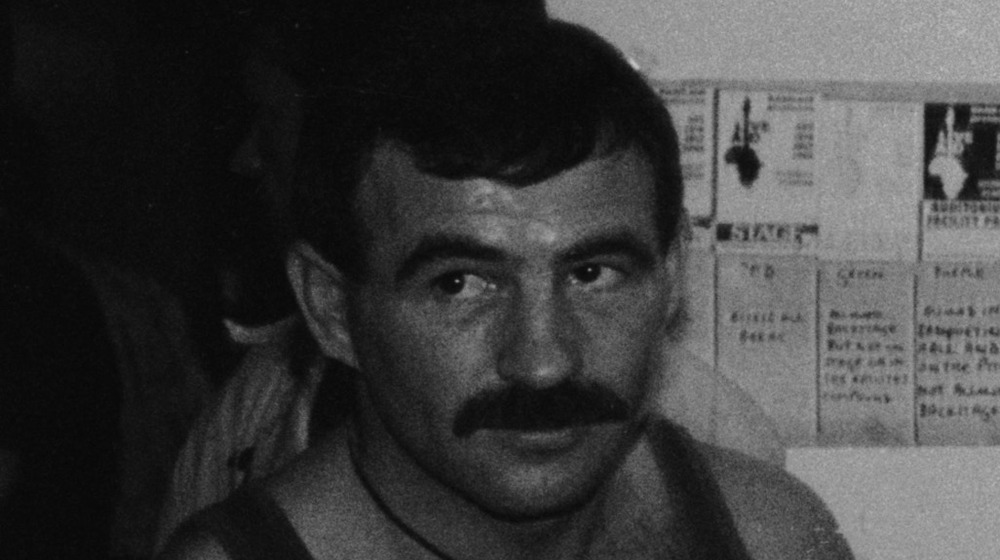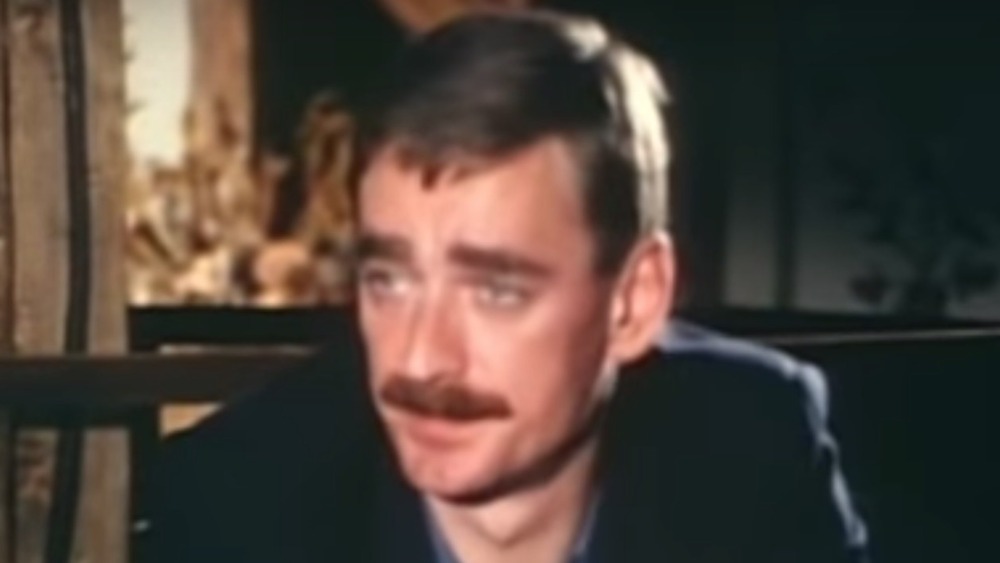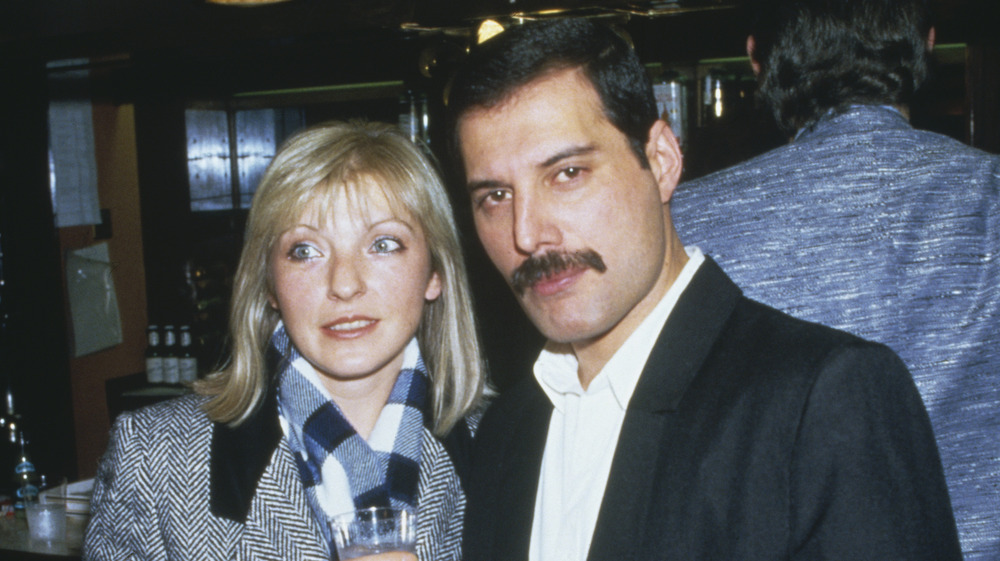What Freddie Mercury Was Like The Last Time These Celebs Saw Him Alive
It is an unquestioned fact that Freddie Mercury was one of the greatest frontmen in the history of popular music. His showmanship was something never before seen in rock and roll history, and for more than two decades, his leadership pushed his band, Queen, to become one of the greatest groups of the 20th century.
This in large part came because of Mercury's voice. To this day, Mercury is considered, by a large portion of music fans, as the greatest vocalist in the genre's history. U Discover Music ranked him No. 1 on their list of the "Best Male Rock Singers," and Mercury is on similar No. 1 lists by LA Weekly and The Top Tens. According to Polyphonic, a group of researchers studied the range of Mercury's voice, finding that his vocal vibrato could jump all the way up to 7.04 Hertz. The average singer's vocal vibrato moves between 5.4-6.9 Hertz.
Mercury and Queen continued to make music throughout the 1980s, even after Mercury was diagnosed with HIV/AIDS in April 1987, as told by Radio.co. Despite, or because of the illness, Mercury milked as much out of his voice as possible. Mercury's 1991 death was not a surprise to those who were close to him, as many stood by his side in the final months, weeks, and days of his life. Here are their last memories they had of the famed rock singer.
Elton John
Elton John might have understood the pressures that Freddie Mercury faced at his zenith better than any other musician. Both were gay British rock stars that were equal parts flamboyant showmen and critically acclaimed singers/songwriters who reached their peaks in the 1970s and 80s. They formed a close friendship during this time. At the end of Mercury's life, John, who lived near Mercury's home, stayed close to his friend/fellow musician till the end of his life.
In an interview while promoting his autobiography, John spoke about seeing Mercury during his final days. According to Smooth Radio, he said this about Mercury's state during his final weeks and how it affected him. "I didn't go and see him often because I found it really, really painful. AIDS was terrifying. He was physically terrifying to look at."
John also commented on his friend indulging in hobbies while suffering from AIDS. "Freddie loved collecting Japanese art and collecting it at auction. So while he was dying he was still buying things at auction. He would be surrounded on a bed and there'd be medicine all around him. Medicine cabinets and pills and auction catalogs."
In one last act of charity, John revealed in the interview that Mercury, who died of AIDS-complicated pneumonia in November 1991, had sent him a Christmas gift. As told by Bored Panda, John received a painting by one of his favorite artists, British painter Henry Scott Tuke, from Mercury, causing him to break down crying.
Montserrat Caballé
Freddie Mercury and Queen were famous for intermixing hard arena rock with classical operatic music. This made his collaboration with famed Spanish operatic soprano, Montserrat Caballé, a match made in heaven. Their duet on the song, "Barcelona," remains one of Mercury's highest-charting singles of his brief solo career. The pair also had great respect for each other's talents.
According to U Discover Music, Mercury had desired to follow his first solo album with a more adventurous sophomore effort. "When I was planning to do my second solo project, I really didn't want it to be just another bunch of songs."
In 1986, the rock singer met the 55-year-old Barcelona operatic soprano. Mercury and arranger Mike Moran played a demo of a song they wanted to give to her, which she loved and then agreed to work on a full album with Mercury. While nervous, and even intimidated, Mercury formed a close friendship with Caballé and their album, 1988's Barcelona, was a success, with the single of the same name being the album's marquee hit.
This success came in spite of Mercury receiving his fatal diagnosis before recording began and showing the effects of the disease in the sessions, as told by NME. The pair hoped that they could perform their song at the 1992 Barcelona Olympic Games. However, in the last interview of her life, Caballé revealed that when she brought the idea up, Mercury told her he would not live to see the Barcelona Games.
Roger Taylor
According to Louder Sound, Queen's drummer and backing vocalist Roger Taylor told BBC Radio in 2020 that he believed that the band would still be around if not for Freddie Mercury's death and that he was his closest friend. "He was my closest friend and we were very, very close. We came up together and we literally lived in each other's pockets and clothes some of the time! I do believe we would still being doing stuff together because it was a great collaboration."
Like the rest of his bandmates, Taylor continued to make music with Mercury until his final months.
Speaking to Reader's Digest, Taylor recalled not realizing the band's tour for their album, A Kind of Magic, would be their last. Taylor remembered Mercury always commenting he did not wish to continue touring, while also knowing Mercury enjoyed the spotlight of concerts and cheering fans.
In an interview a week following Mercury's death, Taylor, along with Brian May, spoke about their bandmate's last years living with the disease. He said during the last music video they made, they were trying to support their sick friend as they and Mercury knew that death was fast approaching. He also described Mercury as a "prisoner in his own house" during the last 18 months of his life, as press and tabloids hounded the private Mercury about his life and visible deterioration. Taylor lambasted the press in the interview, calling one tabloid reporter a "poor old sick devil."
Brian May
Ranked the No. 26 guitarist of all time by Rolling Stone and a talented singer, Brian May would be the headliner for most bands. But with the supersonic force of nature that was Freddie Mercury, May found himself a nice position as the band's lead guitarist and part-time songwriter.
As told by Ultimate Classic Rock, May recalled having dinner with Mercury in his final days and told interviewers the full extent of the disease's effects. During the evening, Mercury showed his friend that a large portion of his foot had to be amputated. Mercury regretted and apologized showing him the remains of his foot, to which May consoled him and told him he only regrets knowing how much pain he was actually in.
Shortly following Mercury's passing, new drugs began to be introduced to the market that could delay the effects of HIV/AIDS and prolong the life of individuals suffering like his departed friend. May said he does not enjoy thinking about this fact, as the Society of Rock reports. "He missed by just a few months. If it had been a bit later he would still have been with us, I'm sure. You can't do 'what if,' can you? You can't go there because therein lies madness."
May penned the only original Queen song following Mercury's death, 1997's No One But You (Only the Good Die Young), a tribute to his fallen friend. According to Songfacts, the song took extra meaning after Princess Diana's death that year.
John Deacon
Bassist John Deacon is the only living member of Queen who is no longer part of the lineup. While Brian May and drummer Roger Taylor have carried on Queen's name, Deacon, according to Ultimate Classic Rock, retired from music in 1997, with many close to him saying that he became despondent after Freddie Mercury's death. May's tribute song to Mercury was the last recording Deacon had done of any kind.
Deacon was seen as Mercury's opposite. According to I Heart Radio, Deacon wanted to avoid the spotlight while Mercury craved it. Still, Deacon had a lot of influence in the band as the group's chief financial advisor and, as Mercury said, "the rest of the group wouldn't do anything unless John said it was alright."
Mercury's agent, Peter Freestone, said of Mercury's and Deacon's relationship, "Freddie took John under his wing because he was the new boy... He wanted to protect him."
In a 2014 interview with Rolling Stone, May and Taylor admitted they had not heard much from their old bassist, saying he is very private and retired. Taylor also said that their former bandmate was "a little fragile." Deacon retired from music after Mercury's passing, aside from the 1992 tribute concert to Mercury and the 1997 song. Their final video together was for Mercury's final music video for "These Are the Days of Our Lives," filmed a few months before Mercury's passing and in black and white to hide the severity of the illness, Rolling Stone reports.
Barbara Valentin
Referred to as the "German Brigitte Bardot," Barbara Valentin became one of Europe's most recognizable sex symbols during her life, as told by Rock Pasta. In 1984, Freddie Mercury met Valentin in Munich, Germany, and the two began the guise of a relationship. The pair grew very close, and Mercury featured her in Queen's music video for "It's a Hard Life."
Valentin's daughter from a previous relationship, Minki Reichardt, said in an interview that she believed Mercury was the true love of her mother's life. However, she also described the relationship as somewhat volatile, with the pair arguing one moment but always finding themselves back into each other's arms.
While Mercury had been in a long-term relationship with another woman named Mary Austin, Mercury's long list of romantic partners were for the most part men, as Biography tells. While friends of the couple acknowledged there was a relationship, and the two shared a bed, they also question how physical the two actually were. Valentin's friend, Elisabeth Volkmann, said that if not for Mercury's sexuality, the pair would have probably married.
The pair was spotted in 1990 at Mercury's birthday party, 14 months before his death, though the relationship soon soured. Believing she was providing rumors to German gossip papers, Mercury ended their relationship and friendship. Valentin herself was not given an invitation to his funeral, as Mercury's friends saw her as manipulative.
Anita Dobson
Like Barbara Valentin, Anita Dobson was an accomplished actor in Europe when she met Freddie Mercury. Unlike the Valentin relationship that turned sour, Dobson and Mercury remained close throughout their lives. How close? Well, as told by What's On TV, Mercury introduced Dobson to her future husband, Mercury's friend and the band's guitarist Brian May.
May and Dobson have been together since 1986, as they told in a 2015 interview on the morning program, Loose Women. During this time, May was still married to his first wife, leading to tabloids and paparazzi following the couple around, according to Alternative Nation. In October 1989, Queen released, "Scandal," written by May, which criticized the press for harassing the couple, as well as for following Mercury who was trying to hide his body's deterioration. The song peaked at No. 25 in the United Kingdom.
Like May, Dobson remained close to Mercury in the final years and months of his life. So close that, according to actress Lucy Boynton in an interview for Grazia Magazine, she spoke often to Dobson when researching her role in the band's 2018 biopic when she played Mercury's longtime friend Mary Austin. "Anita spent so much time with Mary when they were traveling with the band and so it was really interesting to talk to her because she was more focused and picked up more on Mary's idiosyncrasies and mannerisms."
Dobson today is still married to May and has promoted the Mercury Phoenix Trust that fights HIV/AIDS worldwide.
Rudi Dolezal
As a filmmaker and producer, Rudi Dolezal has had a hand in a number of projects for Freddie Mercury and Queen, as the two were close friends. According to People, the two men met when Dolezal was a young television reporter for an Austrian network interviewing the band in Germany, and in a tongue-in-cheek manner, he told Mercury he could direct one of his videos if he needed the help.
Mercury would take him up on the offer throughout the 1980s as Dolezal became a music video specialist and documentarian, working with acts such as David Bowie, Tom Waits, Frank Zappa, and others, as told by POV Magazine. Through working together, Mercury and Dolezal formed a close friendship. Dolezal described working with Mercury to Yahoo News. "Freddie and I developed a language together. He was very, very, fast. He was very intelligent, very clever, and you had to be always on your toes."
The band's last two music videos, "These are the Days of our Lives" and "I'm Going Slightly Mad," which Dolezal worked on and were filmed a few months before Mercury's death, were filmed in black and white to hide Mercury's frail complexion. Dolezal remembered part of Mercury's foot missing and looking emaciated but pushing through.
"Regardless [of] whether he was in pain or not, he always delivered. He didn't want any special treatment. He was so brave. In retrospect, it would have been so easy to be a diva, but he wasn't like that."
Jim Hutton
All That's Interesting reports that Jim Hutton first met Freddie Mercury in the mid-1980s at a London Club. Mercury offered Hutton a drink and, being in a relationship, he refused the singer's flirtation. Eighteen months later, back at the same London Club, the pair hit it off and would become partners until Mercury's death.
According to Vanity Fair, the couple moved in together less than a year into the relationship, though they never came out as a pair due to Mercury wishing to remain in the closet. After a few years into the relationship, Mercury was diagnosed with AIDS in 1987 and told Hutton he would understand if he wanted to end the relationship then and there. Hutton, as told by Irish Central, responded saying, "I love you, Freddie, I'm not going anywhere."
Hutton cared for his partner for the remainder of his days. The pair wore wedding bands to illustrate their commitment, as gay marriage was two-plus decades away from legalization. Hutton recalled the last conversation he had with Mercury, days before his passing. The singer wanted to look at his paintings, and the couple walked downstairs to see them, Hutton staying in front of him to catch him in case he fell. After his death, Mercury left Hutton with £500,000 (nearly $1 million as of 2019), and he moved back to Ireland. Three years later, he would publish Mercury and Me, an autobiography about his relationship with his ex-partner.
Paul Prenter
Paul Prenter will forever remain an important part of the story of Freddie Mercury and Queen, for better and for worse. As told by The Sun, Prenter was Mercury's manager between 1977-86 and was lovers with Mercury for a period. However, his tenure with the group did not end amicably, and he sold a story to the national press claiming that Mercury had hundreds of male lovers, two of which had died of AIDS.
According to Bustle, the first five years of Prenter's relationship with the band was calm and without an issue. This changed in 1982 when bandmates Brian May and Roger Taylor blamed Prenter for the poor sound on their album, Hot Space. Despite this, it was few more years until Mercury dismissed Prenter, who soon went to The Sun and outed Mercury and his relationship with Jim Hutton. He also claimed that the singer had slept with hundreds of men and gave the press private photos from Mercury.
It was reported that Prenter met with Mercury later to ask for financial relief after spending all the money he had made from selling his story to the press. Like Mercury, Prenter would die in 1991 from AIDS. During the production of the 2018 Queen and Mercury biopic, Bohemian Rhapsody, Prenter was played by Allan Leech. The actor told Metro US that May and Taylor would avoid him on set as they still harbored anger towards their old manager.
Mary Austin
Despite his relationship with Barbara Valentin, no other woman was as close to Freddie Mercury as the first love of his life, Mary Austin. According to Biography, the pair met in 1969 when Mercury was 24 and Austin was 19, and they remained close until the end of his life.
According to All That's Interesting, the couple got engaged on Christmas Day in 1973, as Mercury and Queen were a year into their first record deal and already had a hit in the U.K. Despite his rising stardom, Mercury never left Austin's side, even chasing after her when she tried to leave with a departing crowd of fans following one of their shows. However, Mercury and Austin never married, and, according to Austin, he would quickly change the subject anytime she tried to bring up the wedding.
Eventually, the two sat down and discussed their relationship, as Mercury admitted to himself and Austin he was gay. Even after ending the engagement, Mercury wanted Austin to remain close to him and bought her an apartment close to where he lived. His wishes came true, and Austin remained a fixture in his life.
When he was diagnosed with AIDS, Austin and Jim Hutton stood by his side. Austin remembered sitting by Mercury's bed for hours nursing him when he was asleep. The singer would awake with a smile and say, "Oh it's you old faithful." After his passing, Mercury left most of his estate to Austin, as well as his ashes to scatter.
